Detailed Marketing Report: FitLife Health Club Case Study
VerifiedAdded on 2020/10/23
|27
|6734
|82
Report
AI Summary
This report provides a comprehensive analysis of marketing principles and practices, using FitLife, an Australian health club chain, as a case study. The report begins with an introduction to marketing concepts and the context of FitLife. Task 1 identifies key legislation, codes of practice, and national standards relevant to marketing roles, describing their provisions and providing examples of required actions. It also covers communication concepts, data processing methods, and data analysis techniques, including both qualitative and quantitative approaches. Sampling methods, hypothesis development, and research reporting formats are explained. Task 2 focuses on developing research objectives, questions, and hypotheses, along with data collection methods and options for quantifying data. Task 3 outlines the process of identifying and recruiting respondents. Task 4 details data gathering and storage, while Task 5 covers data processing, analysis, and the summarization of findings. Task 6 focuses on report generation and communication of findings. The report covers various aspects of marketing research, including legislation, communication strategies, data analysis, and research methodologies, providing a thorough overview of the marketing process.
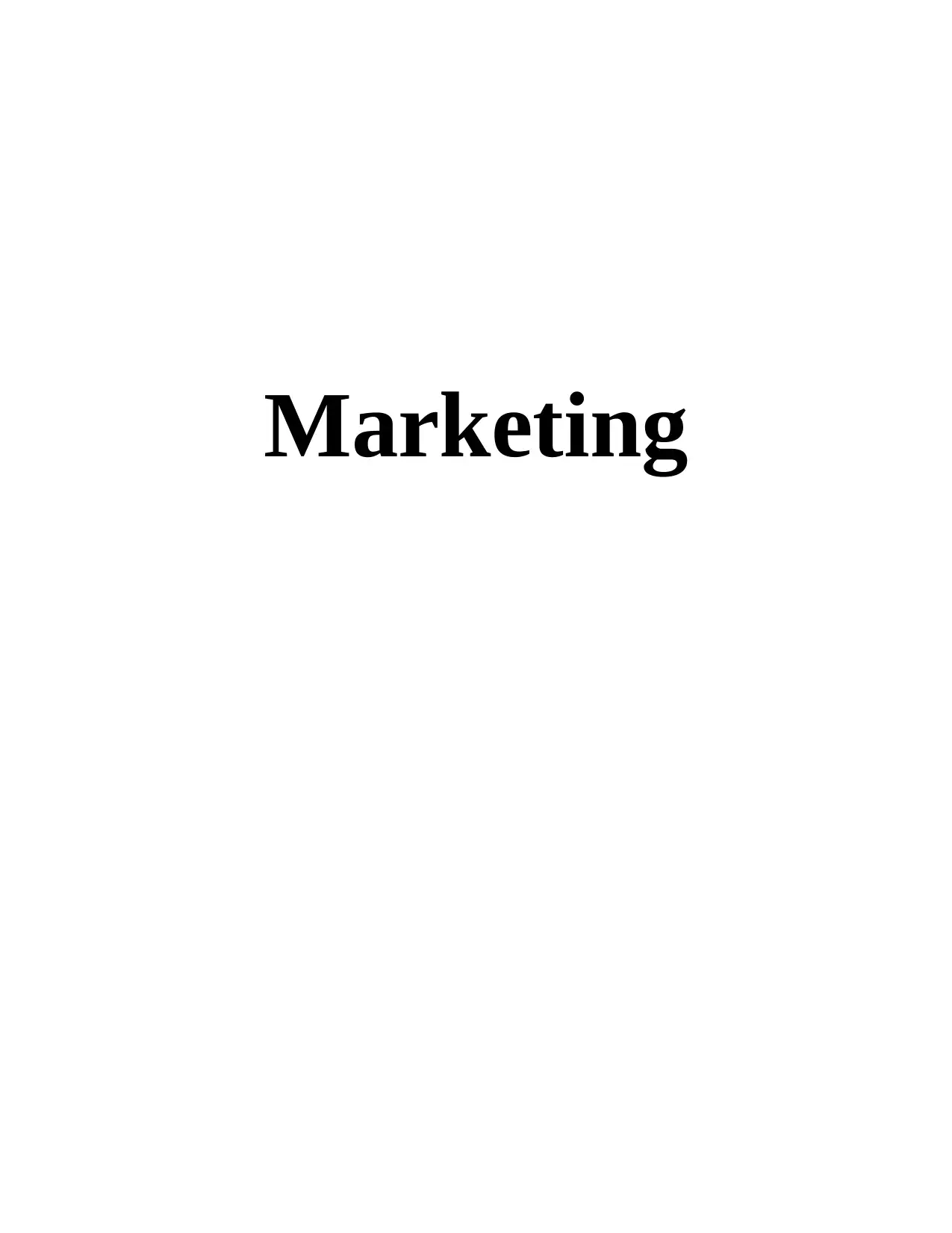
Marketing
Paraphrase This Document
Need a fresh take? Get an instant paraphrase of this document with our AI Paraphraser

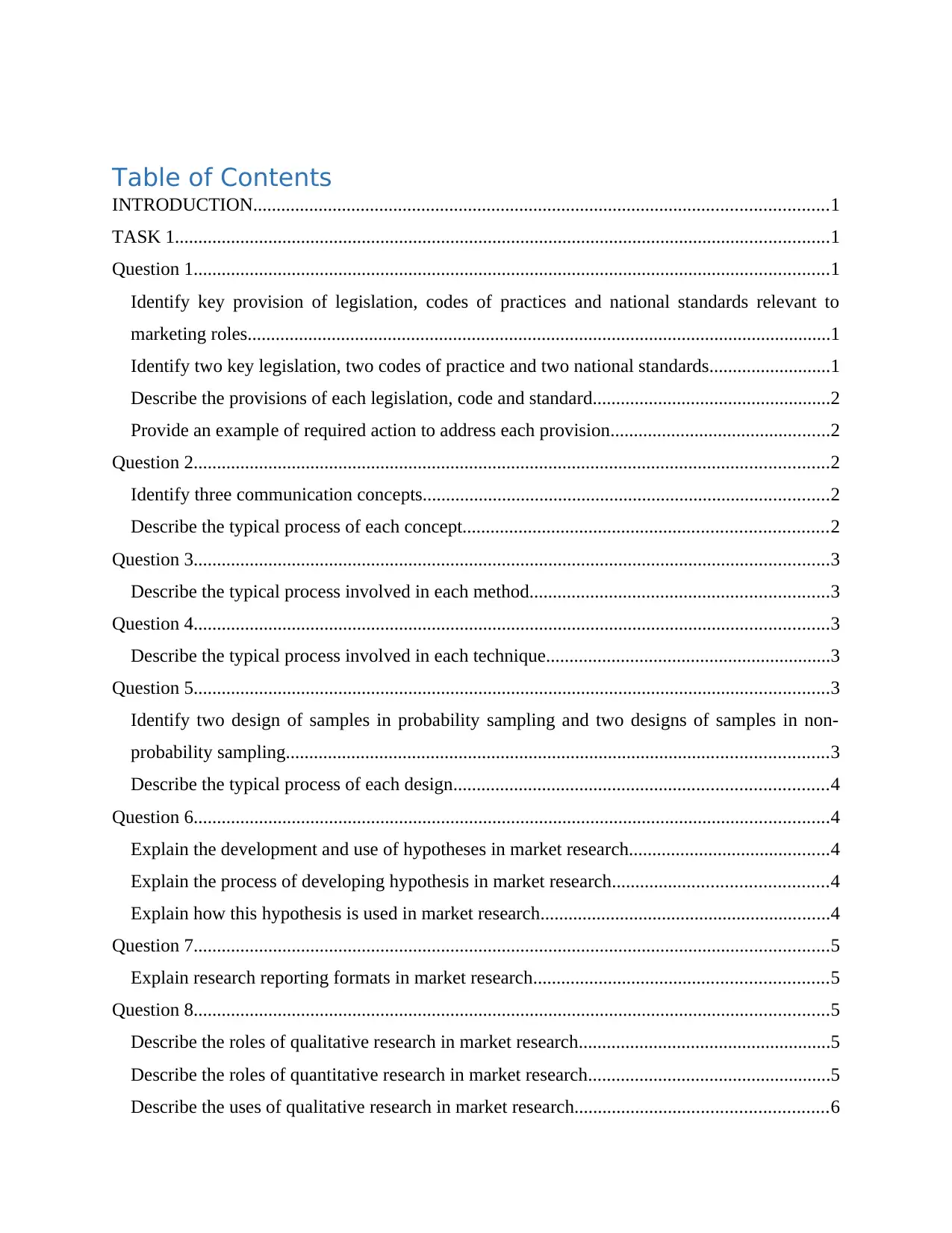
Table of Contents
INTRODUCTION...........................................................................................................................1
TASK 1............................................................................................................................................1
Question 1........................................................................................................................................1
Identify key provision of legislation, codes of practices and national standards relevant to
marketing roles.............................................................................................................................1
Identify two key legislation, two codes of practice and two national standards..........................1
Describe the provisions of each legislation, code and standard...................................................2
Provide an example of required action to address each provision...............................................2
Question 2........................................................................................................................................2
Identify three communication concepts.......................................................................................2
Describe the typical process of each concept..............................................................................2
Question 3........................................................................................................................................3
Describe the typical process involved in each method................................................................3
Question 4........................................................................................................................................3
Describe the typical process involved in each technique.............................................................3
Question 5........................................................................................................................................3
Identify two design of samples in probability sampling and two designs of samples in non-
probability sampling....................................................................................................................3
Describe the typical process of each design................................................................................4
Question 6........................................................................................................................................4
Explain the development and use of hypotheses in market research...........................................4
Explain the process of developing hypothesis in market research..............................................4
Explain how this hypothesis is used in market research..............................................................4
Question 7........................................................................................................................................5
Explain research reporting formats in market research...............................................................5
Question 8........................................................................................................................................5
Describe the roles of qualitative research in market research......................................................5
Describe the roles of quantitative research in market research....................................................5
Describe the uses of qualitative research in market research......................................................6
INTRODUCTION...........................................................................................................................1
TASK 1............................................................................................................................................1
Question 1........................................................................................................................................1
Identify key provision of legislation, codes of practices and national standards relevant to
marketing roles.............................................................................................................................1
Identify two key legislation, two codes of practice and two national standards..........................1
Describe the provisions of each legislation, code and standard...................................................2
Provide an example of required action to address each provision...............................................2
Question 2........................................................................................................................................2
Identify three communication concepts.......................................................................................2
Describe the typical process of each concept..............................................................................2
Question 3........................................................................................................................................3
Describe the typical process involved in each method................................................................3
Question 4........................................................................................................................................3
Describe the typical process involved in each technique.............................................................3
Question 5........................................................................................................................................3
Identify two design of samples in probability sampling and two designs of samples in non-
probability sampling....................................................................................................................3
Describe the typical process of each design................................................................................4
Question 6........................................................................................................................................4
Explain the development and use of hypotheses in market research...........................................4
Explain the process of developing hypothesis in market research..............................................4
Explain how this hypothesis is used in market research..............................................................4
Question 7........................................................................................................................................5
Explain research reporting formats in market research...............................................................5
Question 8........................................................................................................................................5
Describe the roles of qualitative research in market research......................................................5
Describe the roles of quantitative research in market research....................................................5
Describe the uses of qualitative research in market research......................................................6
⊘ This is a preview!⊘
Do you want full access?
Subscribe today to unlock all pages.

Trusted by 1+ million students worldwide
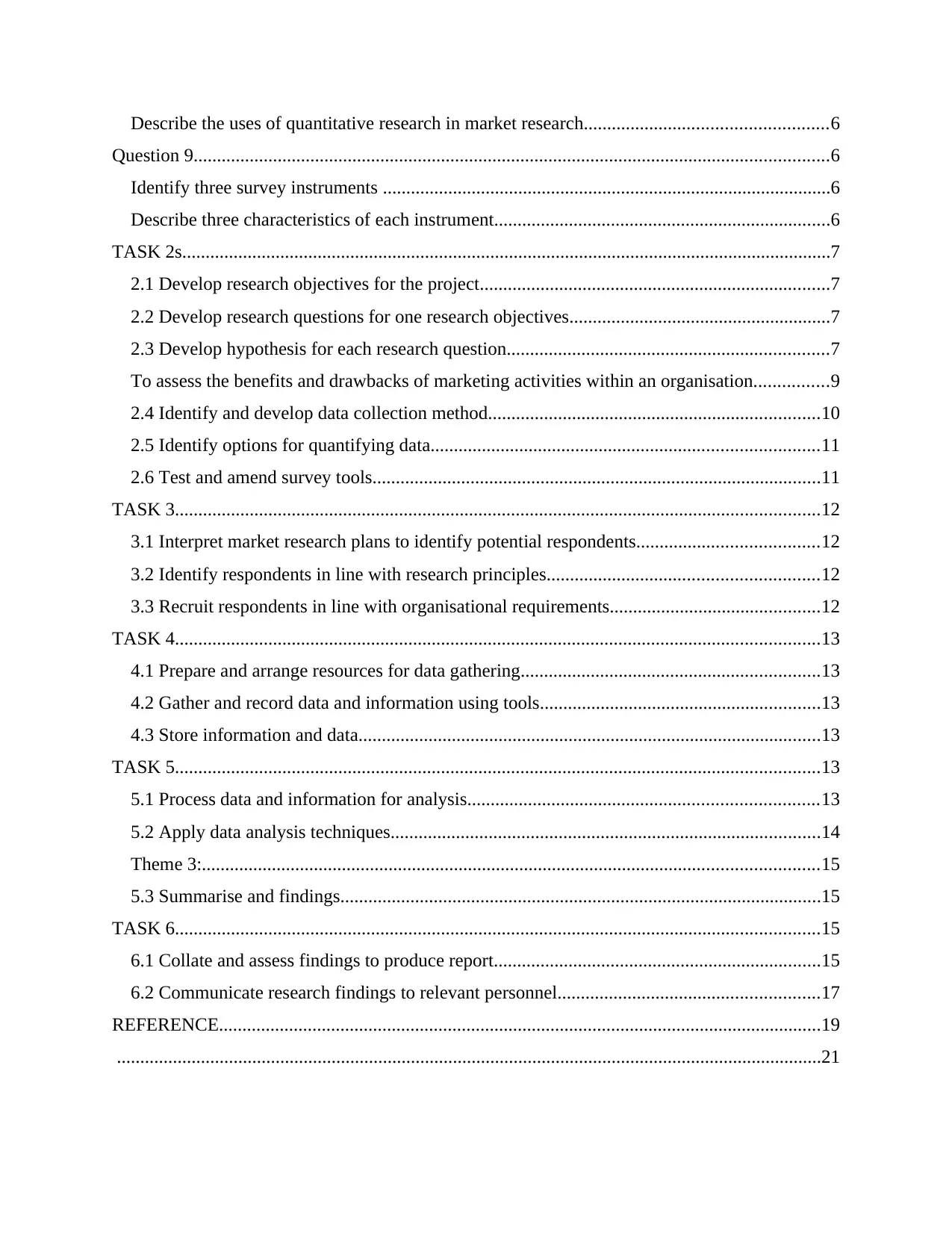
Describe the uses of quantitative research in market research....................................................6
Question 9........................................................................................................................................6
Identify three survey instruments ................................................................................................6
Describe three characteristics of each instrument........................................................................6
TASK 2s...........................................................................................................................................7
2.1 Develop research objectives for the project...........................................................................7
2.2 Develop research questions for one research objectives........................................................7
2.3 Develop hypothesis for each research question.....................................................................7
To assess the benefits and drawbacks of marketing activities within an organisation................9
2.4 Identify and develop data collection method.......................................................................10
2.5 Identify options for quantifying data...................................................................................11
2.6 Test and amend survey tools................................................................................................11
TASK 3..........................................................................................................................................12
3.1 Interpret market research plans to identify potential respondents.......................................12
3.2 Identify respondents in line with research principles..........................................................12
3.3 Recruit respondents in line with organisational requirements.............................................12
TASK 4..........................................................................................................................................13
4.1 Prepare and arrange resources for data gathering................................................................13
4.2 Gather and record data and information using tools............................................................13
4.3 Store information and data...................................................................................................13
TASK 5..........................................................................................................................................13
5.1 Process data and information for analysis...........................................................................13
5.2 Apply data analysis techniques............................................................................................14
Theme 3:....................................................................................................................................15
5.3 Summarise and findings.......................................................................................................15
TASK 6..........................................................................................................................................15
6.1 Collate and assess findings to produce report......................................................................15
6.2 Communicate research findings to relevant personnel........................................................17
REFERENCE.................................................................................................................................19
.......................................................................................................................................................21
Question 9........................................................................................................................................6
Identify three survey instruments ................................................................................................6
Describe three characteristics of each instrument........................................................................6
TASK 2s...........................................................................................................................................7
2.1 Develop research objectives for the project...........................................................................7
2.2 Develop research questions for one research objectives........................................................7
2.3 Develop hypothesis for each research question.....................................................................7
To assess the benefits and drawbacks of marketing activities within an organisation................9
2.4 Identify and develop data collection method.......................................................................10
2.5 Identify options for quantifying data...................................................................................11
2.6 Test and amend survey tools................................................................................................11
TASK 3..........................................................................................................................................12
3.1 Interpret market research plans to identify potential respondents.......................................12
3.2 Identify respondents in line with research principles..........................................................12
3.3 Recruit respondents in line with organisational requirements.............................................12
TASK 4..........................................................................................................................................13
4.1 Prepare and arrange resources for data gathering................................................................13
4.2 Gather and record data and information using tools............................................................13
4.3 Store information and data...................................................................................................13
TASK 5..........................................................................................................................................13
5.1 Process data and information for analysis...........................................................................13
5.2 Apply data analysis techniques............................................................................................14
Theme 3:....................................................................................................................................15
5.3 Summarise and findings.......................................................................................................15
TASK 6..........................................................................................................................................15
6.1 Collate and assess findings to produce report......................................................................15
6.2 Communicate research findings to relevant personnel........................................................17
REFERENCE.................................................................................................................................19
.......................................................................................................................................................21
Paraphrase This Document
Need a fresh take? Get an instant paraphrase of this document with our AI Paraphraser


⊘ This is a preview!⊘
Do you want full access?
Subscribe today to unlock all pages.

Trusted by 1+ million students worldwide
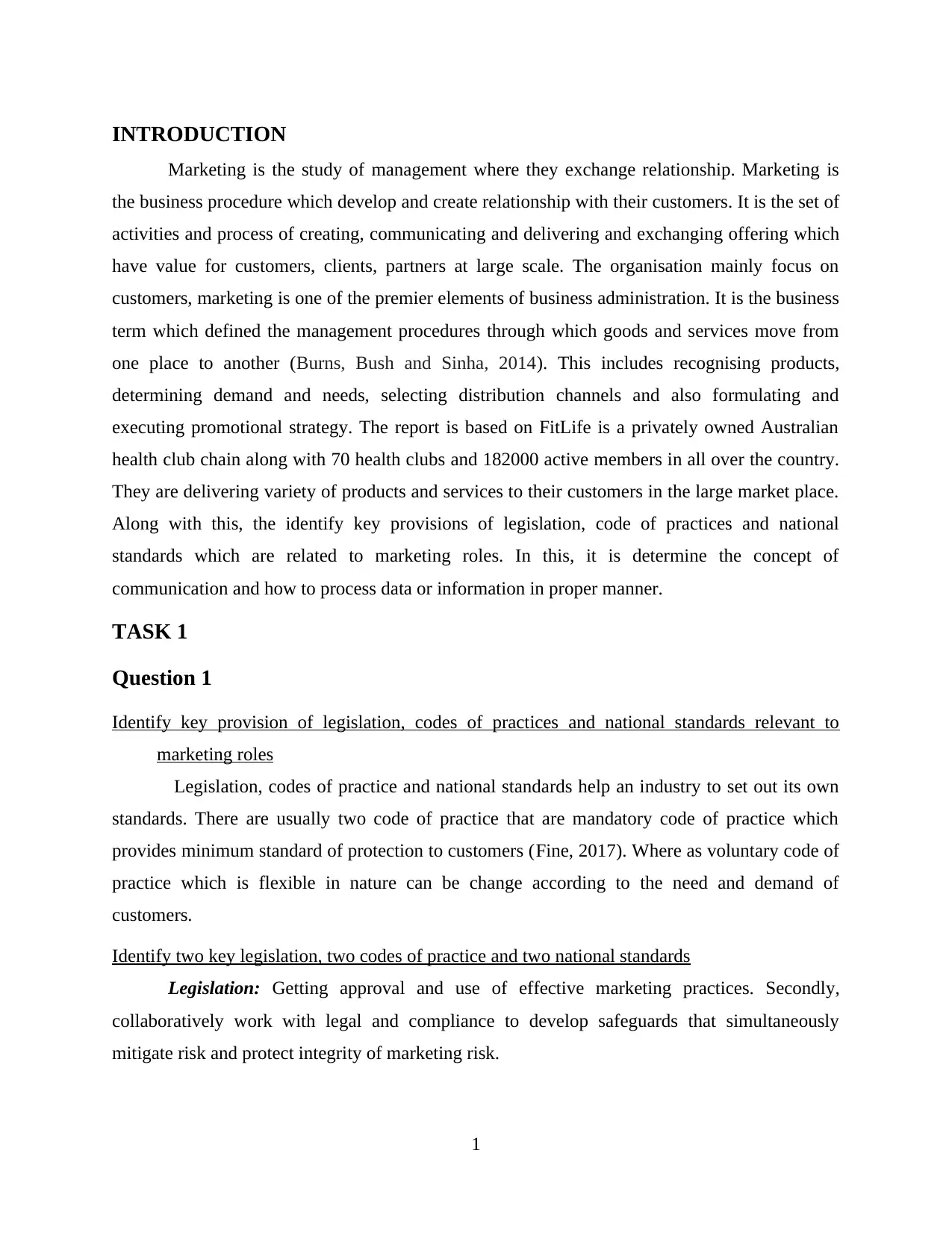
INTRODUCTION
Marketing is the study of management where they exchange relationship. Marketing is
the business procedure which develop and create relationship with their customers. It is the set of
activities and process of creating, communicating and delivering and exchanging offering which
have value for customers, clients, partners at large scale. The organisation mainly focus on
customers, marketing is one of the premier elements of business administration. It is the business
term which defined the management procedures through which goods and services move from
one place to another (Burns, Bush and Sinha, 2014). This includes recognising products,
determining demand and needs, selecting distribution channels and also formulating and
executing promotional strategy. The report is based on FitLife is a privately owned Australian
health club chain along with 70 health clubs and 182000 active members in all over the country.
They are delivering variety of products and services to their customers in the large market place.
Along with this, the identify key provisions of legislation, code of practices and national
standards which are related to marketing roles. In this, it is determine the concept of
communication and how to process data or information in proper manner.
TASK 1
Question 1
Identify key provision of legislation, codes of practices and national standards relevant to
marketing roles
Legislation, codes of practice and national standards help an industry to set out its own
standards. There are usually two code of practice that are mandatory code of practice which
provides minimum standard of protection to customers (Fine, 2017). Where as voluntary code of
practice which is flexible in nature can be change according to the need and demand of
customers.
Identify two key legislation, two codes of practice and two national standards
Legislation: Getting approval and use of effective marketing practices. Secondly,
collaboratively work with legal and compliance to develop safeguards that simultaneously
mitigate risk and protect integrity of marketing risk.
1
Marketing is the study of management where they exchange relationship. Marketing is
the business procedure which develop and create relationship with their customers. It is the set of
activities and process of creating, communicating and delivering and exchanging offering which
have value for customers, clients, partners at large scale. The organisation mainly focus on
customers, marketing is one of the premier elements of business administration. It is the business
term which defined the management procedures through which goods and services move from
one place to another (Burns, Bush and Sinha, 2014). This includes recognising products,
determining demand and needs, selecting distribution channels and also formulating and
executing promotional strategy. The report is based on FitLife is a privately owned Australian
health club chain along with 70 health clubs and 182000 active members in all over the country.
They are delivering variety of products and services to their customers in the large market place.
Along with this, the identify key provisions of legislation, code of practices and national
standards which are related to marketing roles. In this, it is determine the concept of
communication and how to process data or information in proper manner.
TASK 1
Question 1
Identify key provision of legislation, codes of practices and national standards relevant to
marketing roles
Legislation, codes of practice and national standards help an industry to set out its own
standards. There are usually two code of practice that are mandatory code of practice which
provides minimum standard of protection to customers (Fine, 2017). Where as voluntary code of
practice which is flexible in nature can be change according to the need and demand of
customers.
Identify two key legislation, two codes of practice and two national standards
Legislation: Getting approval and use of effective marketing practices. Secondly,
collaboratively work with legal and compliance to develop safeguards that simultaneously
mitigate risk and protect integrity of marketing risk.
1
Paraphrase This Document
Need a fresh take? Get an instant paraphrase of this document with our AI Paraphraser
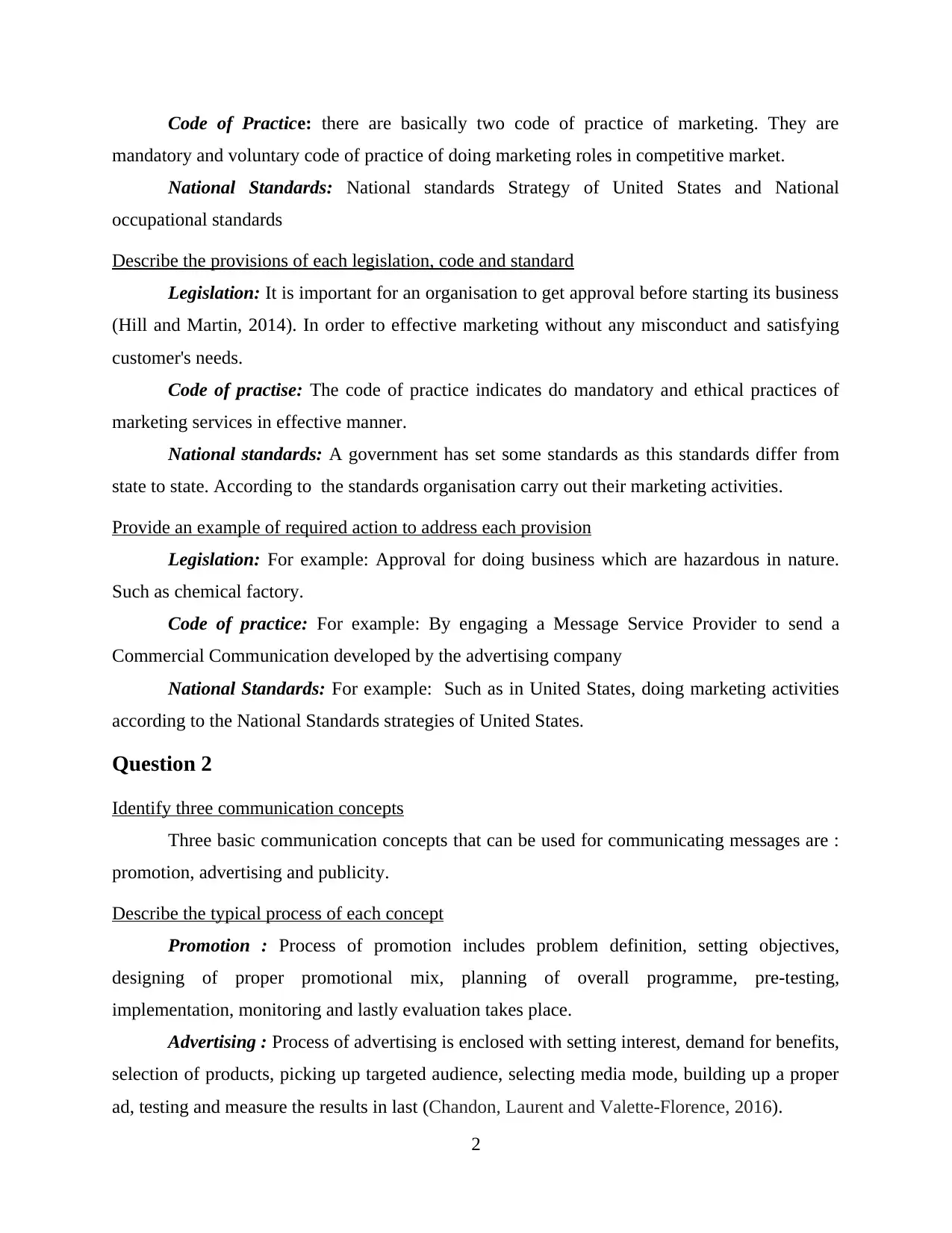
Code of Practice: there are basically two code of practice of marketing. They are
mandatory and voluntary code of practice of doing marketing roles in competitive market.
National Standards: National standards Strategy of United States and National
occupational standards
Describe the provisions of each legislation, code and standard
Legislation: It is important for an organisation to get approval before starting its business
(Hill and Martin, 2014). In order to effective marketing without any misconduct and satisfying
customer's needs.
Code of practise: The code of practice indicates do mandatory and ethical practices of
marketing services in effective manner.
National standards: A government has set some standards as this standards differ from
state to state. According to the standards organisation carry out their marketing activities.
Provide an example of required action to address each provision
Legislation: For example: Approval for doing business which are hazardous in nature.
Such as chemical factory.
Code of practice: For example: By engaging a Message Service Provider to send a
Commercial Communication developed by the advertising company
National Standards: For example: Such as in United States, doing marketing activities
according to the National Standards strategies of United States.
Question 2
Identify three communication concepts
Three basic communication concepts that can be used for communicating messages are :
promotion, advertising and publicity.
Describe the typical process of each concept
Promotion : Process of promotion includes problem definition, setting objectives,
designing of proper promotional mix, planning of overall programme, pre-testing,
implementation, monitoring and lastly evaluation takes place.
Advertising : Process of advertising is enclosed with setting interest, demand for benefits,
selection of products, picking up targeted audience, selecting media mode, building up a proper
ad, testing and measure the results in last (Chandon, Laurent and Valette-Florence, 2016).
2
mandatory and voluntary code of practice of doing marketing roles in competitive market.
National Standards: National standards Strategy of United States and National
occupational standards
Describe the provisions of each legislation, code and standard
Legislation: It is important for an organisation to get approval before starting its business
(Hill and Martin, 2014). In order to effective marketing without any misconduct and satisfying
customer's needs.
Code of practise: The code of practice indicates do mandatory and ethical practices of
marketing services in effective manner.
National standards: A government has set some standards as this standards differ from
state to state. According to the standards organisation carry out their marketing activities.
Provide an example of required action to address each provision
Legislation: For example: Approval for doing business which are hazardous in nature.
Such as chemical factory.
Code of practice: For example: By engaging a Message Service Provider to send a
Commercial Communication developed by the advertising company
National Standards: For example: Such as in United States, doing marketing activities
according to the National Standards strategies of United States.
Question 2
Identify three communication concepts
Three basic communication concepts that can be used for communicating messages are :
promotion, advertising and publicity.
Describe the typical process of each concept
Promotion : Process of promotion includes problem definition, setting objectives,
designing of proper promotional mix, planning of overall programme, pre-testing,
implementation, monitoring and lastly evaluation takes place.
Advertising : Process of advertising is enclosed with setting interest, demand for benefits,
selection of products, picking up targeted audience, selecting media mode, building up a proper
ad, testing and measure the results in last (Chandon, Laurent and Valette-Florence, 2016).
2
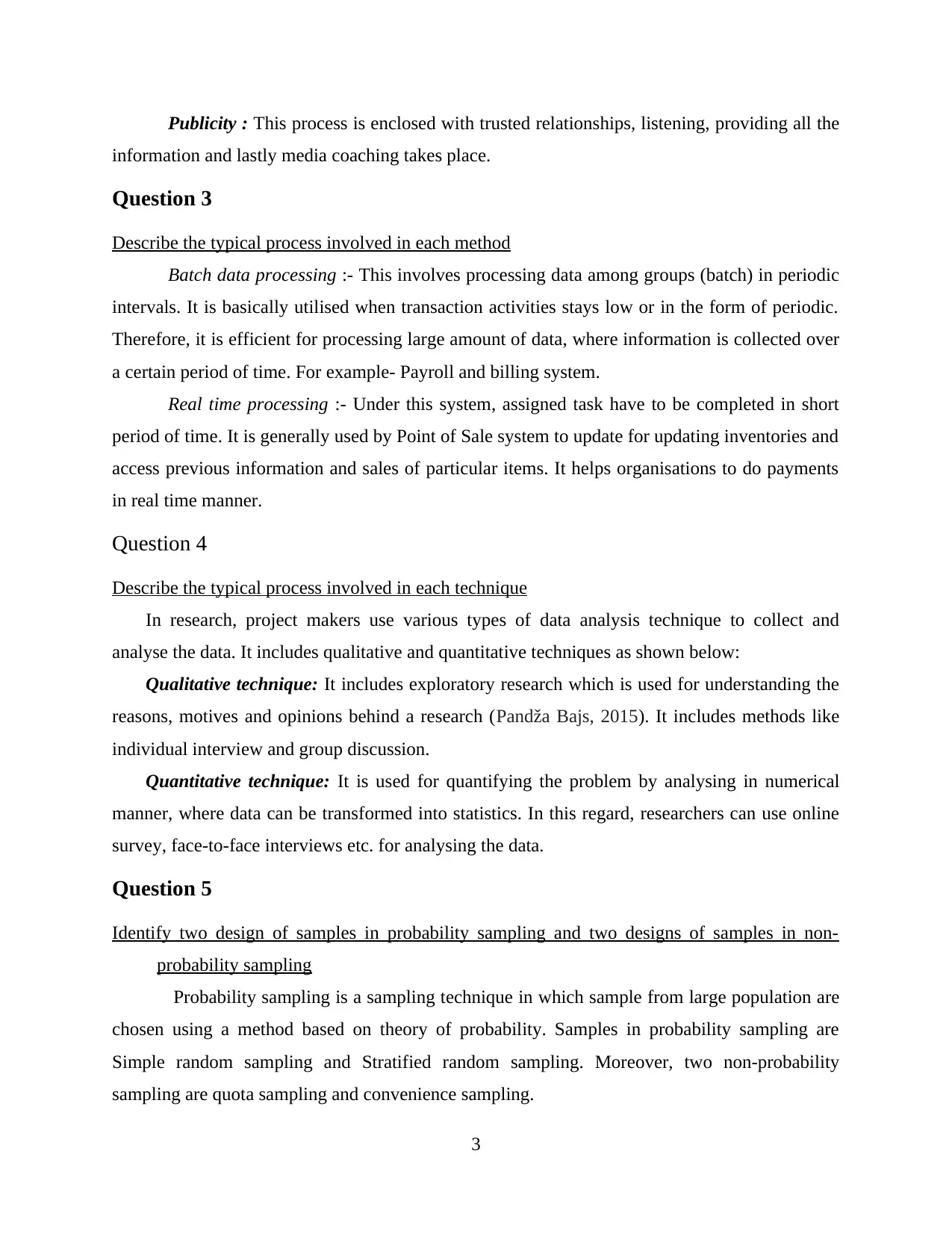
Publicity : This process is enclosed with trusted relationships, listening, providing all the
information and lastly media coaching takes place.
Question 3
Describe the typical process involved in each method
Batch data processing :- This involves processing data among groups (batch) in periodic
intervals. It is basically utilised when transaction activities stays low or in the form of periodic.
Therefore, it is efficient for processing large amount of data, where information is collected over
a certain period of time. For example- Payroll and billing system.
Real time processing :- Under this system, assigned task have to be completed in short
period of time. It is generally used by Point of Sale system to update for updating inventories and
access previous information and sales of particular items. It helps organisations to do payments
in real time manner.
Question 4
Describe the typical process involved in each technique
In research, project makers use various types of data analysis technique to collect and
analyse the data. It includes qualitative and quantitative techniques as shown below:
Qualitative technique: It includes exploratory research which is used for understanding the
reasons, motives and opinions behind a research (Pandža Bajs, 2015). It includes methods like
individual interview and group discussion.
Quantitative technique: It is used for quantifying the problem by analysing in numerical
manner, where data can be transformed into statistics. In this regard, researchers can use online
survey, face-to-face interviews etc. for analysing the data.
Question 5
Identify two design of samples in probability sampling and two designs of samples in non-
probability sampling
Probability sampling is a sampling technique in which sample from large population are
chosen using a method based on theory of probability. Samples in probability sampling are
Simple random sampling and Stratified random sampling. Moreover, two non-probability
sampling are quota sampling and convenience sampling.
3
information and lastly media coaching takes place.
Question 3
Describe the typical process involved in each method
Batch data processing :- This involves processing data among groups (batch) in periodic
intervals. It is basically utilised when transaction activities stays low or in the form of periodic.
Therefore, it is efficient for processing large amount of data, where information is collected over
a certain period of time. For example- Payroll and billing system.
Real time processing :- Under this system, assigned task have to be completed in short
period of time. It is generally used by Point of Sale system to update for updating inventories and
access previous information and sales of particular items. It helps organisations to do payments
in real time manner.
Question 4
Describe the typical process involved in each technique
In research, project makers use various types of data analysis technique to collect and
analyse the data. It includes qualitative and quantitative techniques as shown below:
Qualitative technique: It includes exploratory research which is used for understanding the
reasons, motives and opinions behind a research (Pandža Bajs, 2015). It includes methods like
individual interview and group discussion.
Quantitative technique: It is used for quantifying the problem by analysing in numerical
manner, where data can be transformed into statistics. In this regard, researchers can use online
survey, face-to-face interviews etc. for analysing the data.
Question 5
Identify two design of samples in probability sampling and two designs of samples in non-
probability sampling
Probability sampling is a sampling technique in which sample from large population are
chosen using a method based on theory of probability. Samples in probability sampling are
Simple random sampling and Stratified random sampling. Moreover, two non-probability
sampling are quota sampling and convenience sampling.
3
⊘ This is a preview!⊘
Do you want full access?
Subscribe today to unlock all pages.

Trusted by 1+ million students worldwide
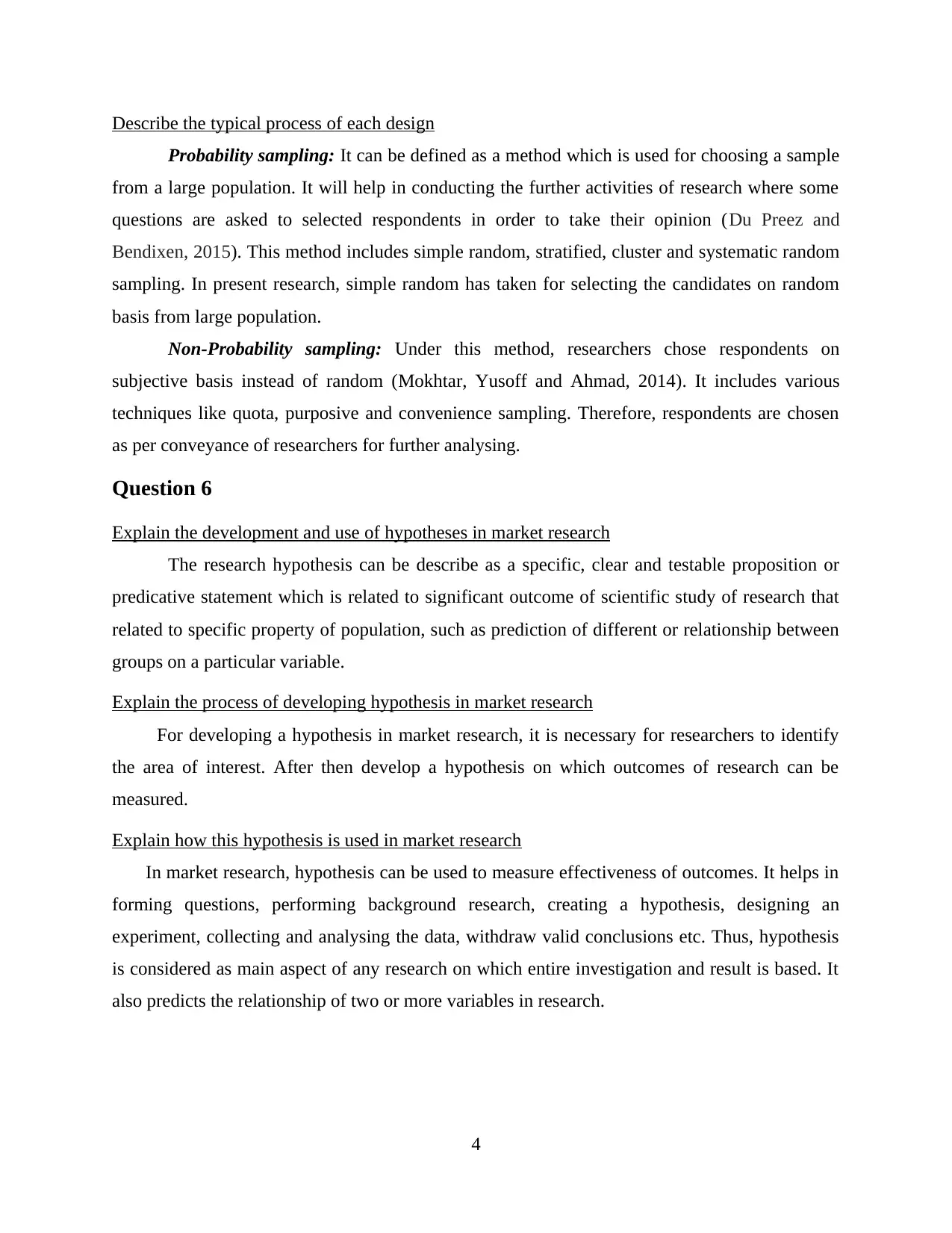
Describe the typical process of each design
Probability sampling: It can be defined as a method which is used for choosing a sample
from a large population. It will help in conducting the further activities of research where some
questions are asked to selected respondents in order to take their opinion (Du Preez and
Bendixen, 2015). This method includes simple random, stratified, cluster and systematic random
sampling. In present research, simple random has taken for selecting the candidates on random
basis from large population.
Non-Probability sampling: Under this method, researchers chose respondents on
subjective basis instead of random (Mokhtar, Yusoff and Ahmad, 2014). It includes various
techniques like quota, purposive and convenience sampling. Therefore, respondents are chosen
as per conveyance of researchers for further analysing.
Question 6
Explain the development and use of hypotheses in market research
The research hypothesis can be describe as a specific, clear and testable proposition or
predicative statement which is related to significant outcome of scientific study of research that
related to specific property of population, such as prediction of different or relationship between
groups on a particular variable.
Explain the process of developing hypothesis in market research
For developing a hypothesis in market research, it is necessary for researchers to identify
the area of interest. After then develop a hypothesis on which outcomes of research can be
measured.
Explain how this hypothesis is used in market research
In market research, hypothesis can be used to measure effectiveness of outcomes. It helps in
forming questions, performing background research, creating a hypothesis, designing an
experiment, collecting and analysing the data, withdraw valid conclusions etc. Thus, hypothesis
is considered as main aspect of any research on which entire investigation and result is based. It
also predicts the relationship of two or more variables in research.
4
Probability sampling: It can be defined as a method which is used for choosing a sample
from a large population. It will help in conducting the further activities of research where some
questions are asked to selected respondents in order to take their opinion (Du Preez and
Bendixen, 2015). This method includes simple random, stratified, cluster and systematic random
sampling. In present research, simple random has taken for selecting the candidates on random
basis from large population.
Non-Probability sampling: Under this method, researchers chose respondents on
subjective basis instead of random (Mokhtar, Yusoff and Ahmad, 2014). It includes various
techniques like quota, purposive and convenience sampling. Therefore, respondents are chosen
as per conveyance of researchers for further analysing.
Question 6
Explain the development and use of hypotheses in market research
The research hypothesis can be describe as a specific, clear and testable proposition or
predicative statement which is related to significant outcome of scientific study of research that
related to specific property of population, such as prediction of different or relationship between
groups on a particular variable.
Explain the process of developing hypothesis in market research
For developing a hypothesis in market research, it is necessary for researchers to identify
the area of interest. After then develop a hypothesis on which outcomes of research can be
measured.
Explain how this hypothesis is used in market research
In market research, hypothesis can be used to measure effectiveness of outcomes. It helps in
forming questions, performing background research, creating a hypothesis, designing an
experiment, collecting and analysing the data, withdraw valid conclusions etc. Thus, hypothesis
is considered as main aspect of any research on which entire investigation and result is based. It
also predicts the relationship of two or more variables in research.
4
Paraphrase This Document
Need a fresh take? Get an instant paraphrase of this document with our AI Paraphraser
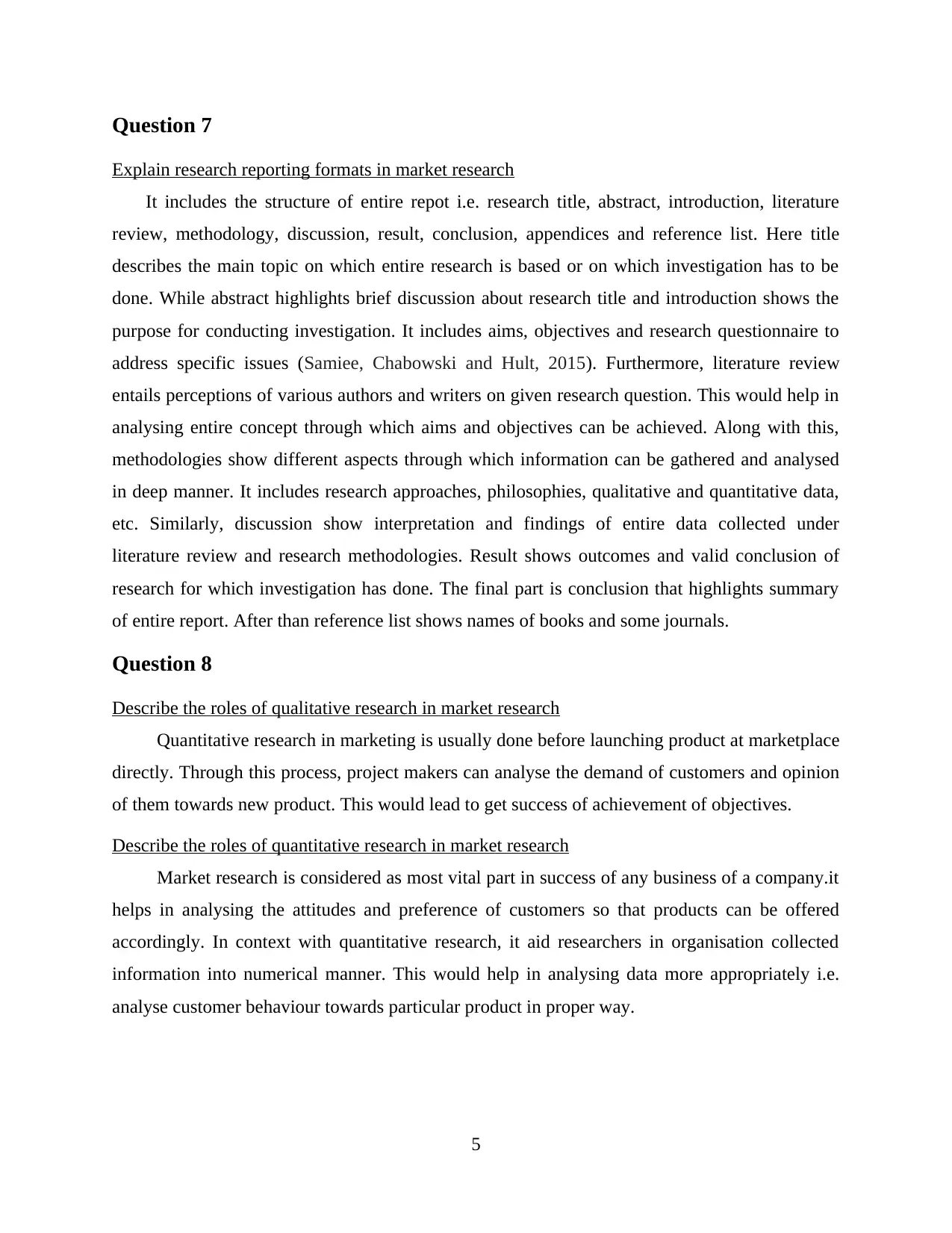
Question 7
Explain research reporting formats in market research
It includes the structure of entire repot i.e. research title, abstract, introduction, literature
review, methodology, discussion, result, conclusion, appendices and reference list. Here title
describes the main topic on which entire research is based or on which investigation has to be
done. While abstract highlights brief discussion about research title and introduction shows the
purpose for conducting investigation. It includes aims, objectives and research questionnaire to
address specific issues (Samiee, Chabowski and Hult, 2015). Furthermore, literature review
entails perceptions of various authors and writers on given research question. This would help in
analysing entire concept through which aims and objectives can be achieved. Along with this,
methodologies show different aspects through which information can be gathered and analysed
in deep manner. It includes research approaches, philosophies, qualitative and quantitative data,
etc. Similarly, discussion show interpretation and findings of entire data collected under
literature review and research methodologies. Result shows outcomes and valid conclusion of
research for which investigation has done. The final part is conclusion that highlights summary
of entire report. After than reference list shows names of books and some journals.
Question 8
Describe the roles of qualitative research in market research
Quantitative research in marketing is usually done before launching product at marketplace
directly. Through this process, project makers can analyse the demand of customers and opinion
of them towards new product. This would lead to get success of achievement of objectives.
Describe the roles of quantitative research in market research
Market research is considered as most vital part in success of any business of a company.it
helps in analysing the attitudes and preference of customers so that products can be offered
accordingly. In context with quantitative research, it aid researchers in organisation collected
information into numerical manner. This would help in analysing data more appropriately i.e.
analyse customer behaviour towards particular product in proper way.
5
Explain research reporting formats in market research
It includes the structure of entire repot i.e. research title, abstract, introduction, literature
review, methodology, discussion, result, conclusion, appendices and reference list. Here title
describes the main topic on which entire research is based or on which investigation has to be
done. While abstract highlights brief discussion about research title and introduction shows the
purpose for conducting investigation. It includes aims, objectives and research questionnaire to
address specific issues (Samiee, Chabowski and Hult, 2015). Furthermore, literature review
entails perceptions of various authors and writers on given research question. This would help in
analysing entire concept through which aims and objectives can be achieved. Along with this,
methodologies show different aspects through which information can be gathered and analysed
in deep manner. It includes research approaches, philosophies, qualitative and quantitative data,
etc. Similarly, discussion show interpretation and findings of entire data collected under
literature review and research methodologies. Result shows outcomes and valid conclusion of
research for which investigation has done. The final part is conclusion that highlights summary
of entire report. After than reference list shows names of books and some journals.
Question 8
Describe the roles of qualitative research in market research
Quantitative research in marketing is usually done before launching product at marketplace
directly. Through this process, project makers can analyse the demand of customers and opinion
of them towards new product. This would lead to get success of achievement of objectives.
Describe the roles of quantitative research in market research
Market research is considered as most vital part in success of any business of a company.it
helps in analysing the attitudes and preference of customers so that products can be offered
accordingly. In context with quantitative research, it aid researchers in organisation collected
information into numerical manner. This would help in analysing data more appropriately i.e.
analyse customer behaviour towards particular product in proper way.
5
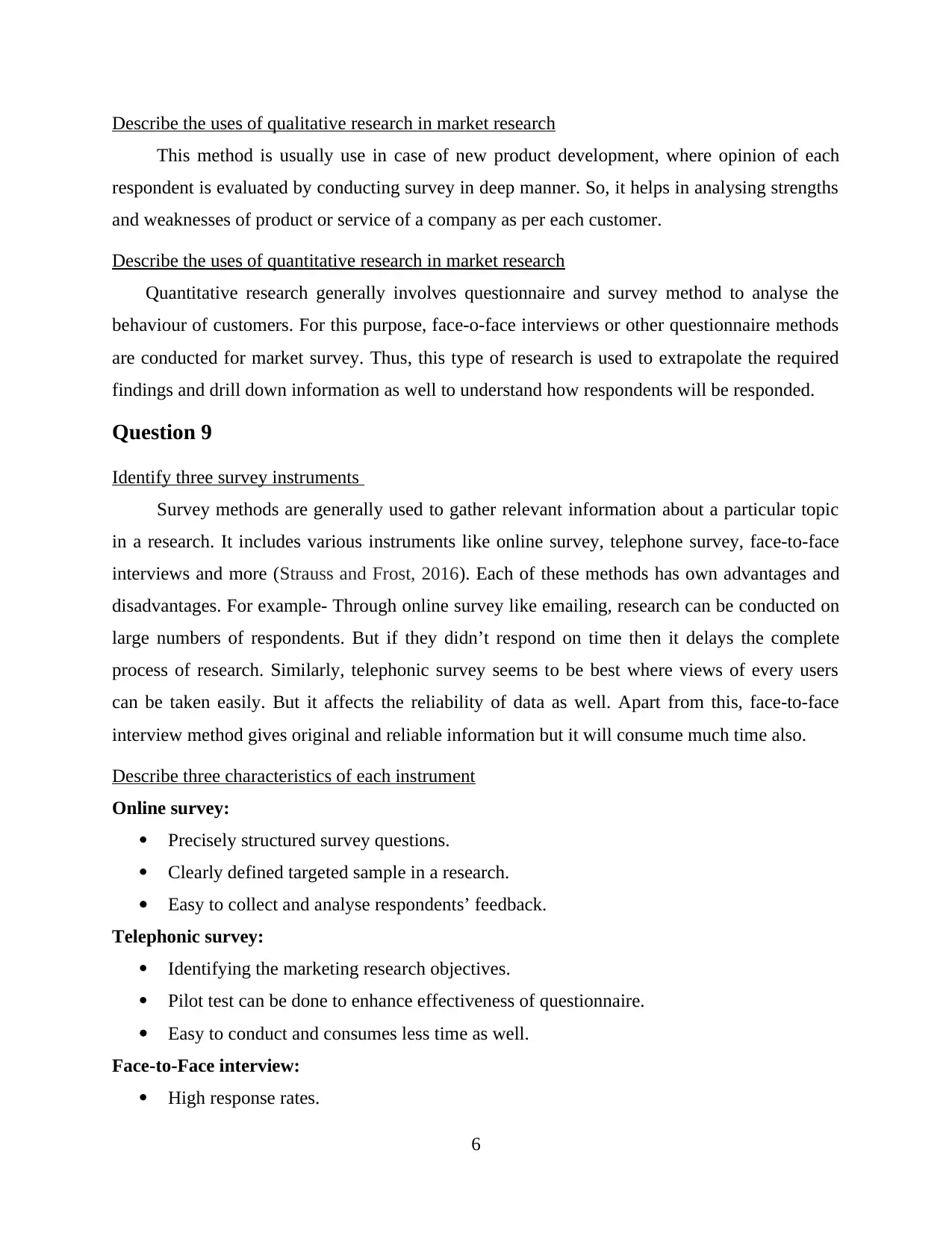
Describe the uses of qualitative research in market research
This method is usually use in case of new product development, where opinion of each
respondent is evaluated by conducting survey in deep manner. So, it helps in analysing strengths
and weaknesses of product or service of a company as per each customer.
Describe the uses of quantitative research in market research
Quantitative research generally involves questionnaire and survey method to analyse the
behaviour of customers. For this purpose, face-o-face interviews or other questionnaire methods
are conducted for market survey. Thus, this type of research is used to extrapolate the required
findings and drill down information as well to understand how respondents will be responded.
Question 9
Identify three survey instruments
Survey methods are generally used to gather relevant information about a particular topic
in a research. It includes various instruments like online survey, telephone survey, face-to-face
interviews and more (Strauss and Frost, 2016). Each of these methods has own advantages and
disadvantages. For example- Through online survey like emailing, research can be conducted on
large numbers of respondents. But if they didn’t respond on time then it delays the complete
process of research. Similarly, telephonic survey seems to be best where views of every users
can be taken easily. But it affects the reliability of data as well. Apart from this, face-to-face
interview method gives original and reliable information but it will consume much time also.
Describe three characteristics of each instrument
Online survey:
Precisely structured survey questions.
Clearly defined targeted sample in a research.
Easy to collect and analyse respondents’ feedback.
Telephonic survey:
Identifying the marketing research objectives.
Pilot test can be done to enhance effectiveness of questionnaire.
Easy to conduct and consumes less time as well.
Face-to-Face interview:
High response rates.
6
This method is usually use in case of new product development, where opinion of each
respondent is evaluated by conducting survey in deep manner. So, it helps in analysing strengths
and weaknesses of product or service of a company as per each customer.
Describe the uses of quantitative research in market research
Quantitative research generally involves questionnaire and survey method to analyse the
behaviour of customers. For this purpose, face-o-face interviews or other questionnaire methods
are conducted for market survey. Thus, this type of research is used to extrapolate the required
findings and drill down information as well to understand how respondents will be responded.
Question 9
Identify three survey instruments
Survey methods are generally used to gather relevant information about a particular topic
in a research. It includes various instruments like online survey, telephone survey, face-to-face
interviews and more (Strauss and Frost, 2016). Each of these methods has own advantages and
disadvantages. For example- Through online survey like emailing, research can be conducted on
large numbers of respondents. But if they didn’t respond on time then it delays the complete
process of research. Similarly, telephonic survey seems to be best where views of every users
can be taken easily. But it affects the reliability of data as well. Apart from this, face-to-face
interview method gives original and reliable information but it will consume much time also.
Describe three characteristics of each instrument
Online survey:
Precisely structured survey questions.
Clearly defined targeted sample in a research.
Easy to collect and analyse respondents’ feedback.
Telephonic survey:
Identifying the marketing research objectives.
Pilot test can be done to enhance effectiveness of questionnaire.
Easy to conduct and consumes less time as well.
Face-to-Face interview:
High response rates.
6
⊘ This is a preview!⊘
Do you want full access?
Subscribe today to unlock all pages.

Trusted by 1+ million students worldwide
1 out of 27
Related Documents
Your All-in-One AI-Powered Toolkit for Academic Success.
+13062052269
info@desklib.com
Available 24*7 on WhatsApp / Email
![[object Object]](/_next/static/media/star-bottom.7253800d.svg)
Unlock your academic potential
Copyright © 2020–2025 A2Z Services. All Rights Reserved. Developed and managed by ZUCOL.


